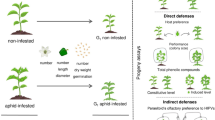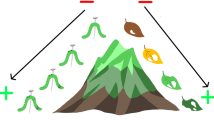Abstract
The effect of select Populus clones on adult cottonwood leaf beetle feeding preferences was examined. Field-planted University of Washington poplar pedigree materials—parent clones ILL-129 (Populus delloides) and 93-968 (Populus trichocarpa), F1 clones 53-242 and 53-246, and 87 F2 selections—were used. Both field cage feeding tests with parent and F1 clones, and leaf disc feeding tests with all 91 clones were performed. Feeding stimulants on the leaf surface, long-chain fatty alcohols and α-tocopherylquinone (α-TQ), and phenolic glycosides, tremulacin and salicortin, were analyzed to correlate chemical abundance with cottonwood leaf beetle Chrysomela scripta adult feeding preference. The beetles showed varied feeding preferences among parent clones, F1 clones, and F2 clones. Contents of alcohols, tremulacin, and salicortin did not explain adult beetle feeding preference. Content of α-TQ on the leaf surface did explain the adult beetle feeding preference. The beetles preferred to feed on clones with α-TQ rather than clones without α-TQ. As the amount of α-TQ increased, the feeding preference increased, and then decreased as the amount of α-TQ increased further.
Similar content being viewed by others
REFERENCES
Adati, T., and Matsuda, K. 1993. Feeding stimulants for various leaf beetles (Coleoptera: Chrysomelidae) in the leaf surface wax of their host plants. Appl. Entomol. Zool. 28:319-324.
Bingaman, B. R., and Hart, E. R. 1992. Feeding and oviposition preferences of adult cottonwood leaf beetles (Coleoptera: Chrysomelidae) among Populus clones and leaf age classes. Environ. Entomol. 21:508-517.
Bingaman, B. R., and Hart, E. R. 1993. Clonal and leaf age variation in Populus phenolic glycosides: implications for host selection by Chrysomela scripta (Coleoptera: Chrysomelidae). Environ. Entomol. 22:397-403.
Bradshaw, H. D., Jr, and Stettler, R. F. 1993. Molecular genetics of growth and development in Populus. I. Triploidy in hybrid poplars. Theor. Appl. Genet. 86:301-307.
Burkot, T. R., and Benjamin, D. M. 1979. The biology and ecology of the cottonwood leaf beetle, Chrysomela scripta (Coleoptera: Chrysomelidae), on tissue cultured hybrid Aigeiros (Populus × Euramericana) subclones in Wisconsin. Can. Entomol. 111:551-556.
Caldbeck, E. S., McNabb, H. S., Jr., and Hart, E. R. 1978. Poplar clonal preferences of the cottonwood leaf beetle. J. Econ. Entomol. 71:518-520.
Chapman, R. F., and Bernays, E. A. 1989. Insect behavior at the leaf surface and learning as aspects of host plant selection. Experientia 45:215-222.
Cochran, W. G., and Cox, G. M. 1957. Experimental Designs, 2nd ed. John Wiley and Sons, New York, p. 535.
Denno, R. F., Larsson, S., and Olmstead, K. L. 1990. Role of enemy-free space and plant quality in host-plant selection by willow beetles. Ecology 71(1):124-137.
Eigenbrode, S. D., and Espelie, K. E. 1995. Effects of plant epicuticular lipids on insect herbivores. Annu. Rev. Entomol. 40:171-194.
Espelie, K. E., Bernays, E. A., and Brown, J. J. 1991. Plant and insect cuticular lipids serve as behavioral cues for insects. Arch. Insect Biochem. Physiol. 17:223-233.
Faltonson, R. R., Thompson, D., and Gordon, J. G. 1983. Propagation of poplar clones for controlled-environmental studies, pp. 1-11, in Methods of Rapid Early Selection of Poplar Clones for Maximum Yield Potential: A Manual of Procedures. US Department of Agriculture Forest Service North Central Experiment Station, General Technical Report NC-81.
Harrell, M. O., Benjamin, D. M., Berbee, J. G., and Burkot, T. R. 1981. Evaluation of adult cottonwood leaf beetle, Chrysomela scripta (Coleoptera: Chrysomelidae), feeding preference for hybrid poplars, Great Lakes Entomol. 14:181-184.
Harrell, M. O., Benjamin, D. M., Berbee, J. G., and Burkot, T. R. 1982. Consumption and utilization of leaf tissue of tissue-cultured Populus × euramericana by the cottonwood leaf beetle, Chrysomela scripta (Coleopteral: Chrysomelidae). Can. Entomol. 114:743-749.
Kelly, M. T., and Curry, J. P. 1991. The influence of phenolic compounds on the suitability of three Salix species as hosts for the willow beetle Phratora vulgatissima. Entomol. Exp. Appl. 61:25-32.
Kolehmainen, J., Roininen, H., Julkunen-Tiitto, R., and Tahvanainen, J. 1994. Importance of phenolic glucosides in host selection of shoot galling sawfly, Euura amerinae, on Salix pentandra. J. Chem. Ecol. 20:2455-2465.
Kolehmainen, J., Julkunen-Tiitto, R., Roininen, H., and Tahvanainen, J. 1995. Phenolic glucosides as feeding cues for willowing-feeding leaf beetles. Entomol. Exp. Appl. 74:235-243.
Kruk, J., and Strzalka, K. J. 1995. Occurrence and function of a-tocopherol quinone in plants. Plant Physiol. 145:405-409.
Lin, S., Binder, B. F., and Hart, E. R. 1998. Insect feeding stimulants from the leaf surface of Populus. J. Chem. Ecol. 24:1781-1790.
Lindroth, R. L. 1991. Biochemical ecology of aspen-Lepidoptera interaction. J. Kans. Entomol. Soc. 64:372-380.
Lindroth, R. L., Hsiao, M. T. S., and Scriber, J. M. 1987. Characterization of phenolic glycosides from quaking aspen. Biochem. Syst. Ecol. 15:677-680.
Matsuki, M., and Maclean, S. F., Jr. 1994. Effects of different leaf traits on growth rates of insect herbivores on willows. Oecologia 100:141-152.
Metcalf, R. L., and Metcalf, E. R. 1992. Diabroticite rootworm beetles, pp. 64-108, in Plant Kairomones in Insect Ecology and Control. Chapman and Hall, New York.
Orians, C. M. 1995. Preserving leaves for tannin and phenolic glycoside analysis: A comparison of methods using three willow taxa. J. Chem. Ecol. 21:1235-1243.
Palo, R. T. 1984. Distribution of birch (Betula spp.) willow (Salix spp.) and poplar (Populus spp.) secondary metabolites and their potential role as chemical defense against herbivores. J. Chem. Ecol. 10:499-520.
Pasteels, J. M., Rowell-Rahier, M. and Raupp, M. J. 1989. Plant-derived defense in Chrysomelid beetles, pp. 235-272, in P. Barbosa and D. Letourneau (eds.). Novel Aspects of Insect-Plant Interactions. John Wiley & Sons, New York.
Picard, S., Chenault, J., Augustin, S., and Venot, C. 1994. Isolation of a new phenolic compound from leaves of Populus deltoides. J. Nat. Prod. 57:808-810.
Rank, N. E. 1992. Host plant preference based on salicylate chemistry in a willow leaf beetle (Chrysomela aeneicollis). Oecologia 90:95-101.
Rank, N. E. 1994. Host-plant effects on larval survival of a salicin-using leaf beetle Chrysomela aeneicoli Schaeffer (Coleoptera: Chrysomelidae). Oecologia 97:342-353.
Rowell-Rahier, M., and Pasteels, J. M. 1982. The significance of salicin-feeder, Phratora (Phyllodecta) viellinae, pp. 73-79, in Proceedings, 5th International Symposium on Insect-Plant Relationship, Wageningen, Pudoc, Wageningen.
Rowell-Rahier, M., Soetens, PH. and Pasteels, J. M. 1987. Influence of phenolicglucosides on the distribution of herbivores on willows, pp. 91-95, in V. Labeyrie, G. Fabres and D. Lachaise (eds.). Insects-Plants. Dr. W. Junk Publishers, Dordrecht, The Netherlands.
SAS. 1985. SAS Institute Inc., Cary, North Carolina.
Smiley, J. T., Horn, J. M., and Rank, N. E. 1985. Ecological effects of salicin at three trophic levels: New problems from old adaptations. Science 229:649-651.
StÄdler, E. 1986. Oviposition and feeding stimuli in leaf surface waxes, pp. 105-121, in B. Juniper, and S. R. Southwood (eds.). Insects and the Plant Surface. Edward Arnold, Baltimore, Maryland.
StÄdler, E., and Roessingh, P. 1991. Perception of surface chemicals by feeding and ovipositing insects, pp. 71-86, in A. Szentesi and T. Jermy (eds.). Proceeding 7th International Symposium of Insect-Plant Relationships. Akademiai Kiado, Budapest.
Wallace, J. B., and Blum, M. S. 1969. Refined defensive mechanisms in Chrysomela scripta. Ann. Entomol. Soc. Am. 62:503-506.
Walton, T. J. 1990. Waxes, cutin and suberin, pp. 106-168, in J. L. Harwood and J. R. Bowyer (eds.). Methods in Plant Biochemistry, Vol. 4. Academic Press, San Diego.
Wilson, L. F. 1979. Insect pests of Populus in the Lake States, pp. 75-81, in Proceedings, 16th Annual Meeting, North American Poplar Council, Thompsonville, Michigan.
Woodhead, S., and Chapman, R. F. 1986. Insect behavior and the chemistry of plant surface waxes, pp. 123-135, in B. Juniper and S. R. Southwood (eds.). Insects and the Plant Surface. Edward Arnold, Baltimore, Maryland.
Author information
Authors and Affiliations
Rights and permissions
About this article
Cite this article
Lin, S., Binder, B.F. & Hart, E.R. Chemical Ecology of Cottonwood Leaf Beetle Adult Feeding Preferences on Populus . J Chem Ecol 24, 1791–1802 (1998). https://doi.org/10.1023/A:1022303532306
Issue Date:
DOI: https://doi.org/10.1023/A:1022303532306




